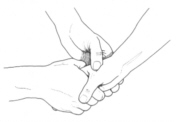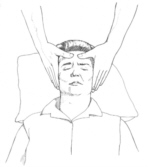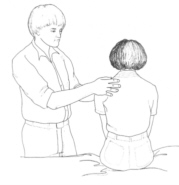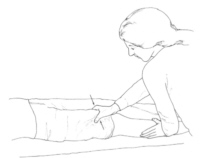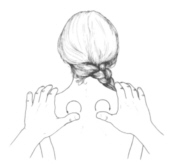Chinese TuiNa
Tui-Na Bodywork
See our Chinese Tui Na Energy Balance Massage DVD
Learn this method for yourself now!
Tui Na is a comprehensive system of therapeutic massage and passive/active joint restoration. The system, as it was taught to me, includes categories of general massage, massage therapy, trigger release, strain/counterstrain, soft circular manipulation, angular maneuvers, moxibustion and cupping techniques.
The traditional Tui-Na school of thought is composed of eight main massage techniques as follows. It should be noted however, that once the main techniques are understood they are combined in myriad ways to get different results depending on the individual syndrome to be treated. The classic texts of Tui Na from the old school proclaim that: "Techniques are techniques, but the hands are the law." Meaning that methods should be adjusted as necessary based on individual needs. Simply performing things by the numbers is seldom efficient or beneficial. The basics are designed to aid the new practitioner in the learning process.
The Eight Primary Tui Na Techniques
Tui - To Push,
- Tui of the Thumbs - Applied along the more "bony" areas of the body.
- Tui of the Fingertips - Applied along the more "fleshy" areas of the body.
- Tui of the Half Knuckles - Applied to the "hollow" areas of the body. In example: back of the knee, inner elbow, lower back, etc.
Na - To Pull or Drag,
- Na of the Fingertips - Applied along specific meridian structures everywhere on the body.
- Na of the Half Knuckles - Applied to the meridian structures of the back and legs.
An - Rapid & Rythmical Pressing,
- An of the Thumbs - Applied to the Head, Chest, Breast, Back and Legs to specific meridian structures everywhere.
Tao - Strong Pinching Pressure,
- Tao of the Thumb & Index Finger - Applied to specific Acupuncture Points everywhere on the body.
- Tao of the Singular Finger - Sometimes Called the "Finger Dig" method. A very strong stimulatory technique applied to specific Acupuncture Points everywhere on the body.
Nie - Kneading,
- Nie of the Fingers - Applied to the Lower Back and Abdominal area mostly. Also sometimes used along key tendon structures everywhere.
- Nie of the Full Palms - Applied to the Back, Chest, Abdomen and Legs.
Nien - Nipping,
- Nien of the Thumb & Index Finger - Applied to Specific Tendon Structures everywhere on the body.
- Nien of the Half Knuckles - Applied to specific Acupuncture Points everywhere on the body.
Moa - Rubbing,
- Moa of the Palms - Applied to disburse Bruising, everywhere on the body.
- Moa of the Fingers - Applied to disburse Bruising, everywhere on the body.
Pai - Tapping,
- Pai of the Cupped Palms - Applied to the back and legs.
- Pai of the Edged Palms - Applied to the back and shoulders.
- Pai of the Joined Fingers - Applied to the back.
Tui-Na Diagnostics
Tui Na is indeed a part of traditional Chinese Medical practice and as such must utilize the Five Directions of Diagnosis to be effective in rendering treatment. Of the five main diagnostic directions; Asking, Looking, Feeling, Listening and Smelling, only the first three apply strongly to Tui Na therapy as a treatment modality. The patient must be questioned thoroughly in terms of his perspectives of how and when the syndrome first arose, the practitioner must utilize visual diagnostic skills to determine any physical imbalance and/or possible joint subluxation, and the practitioner must gently probe the injured/painful area to determine the nature of the imbalance of subluxation should one indeed exist. The final two directions of diagnosis apply primarily to internal imbalance and Tui Na deals almost exclusively with physical/structural imbalance only.
See our Chinese Tui Na Energy Balance Massage DVD
This method has been acclaimed by professional body workers as extremely effective stand alone modality toward better body balance.
Learn this method for yourself now!

